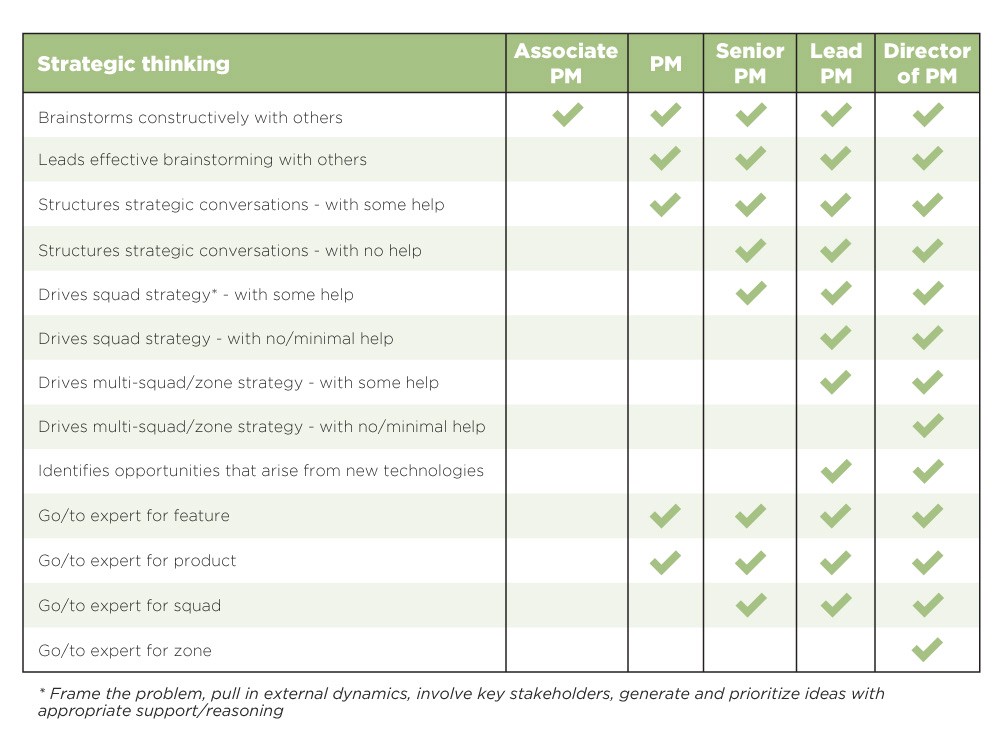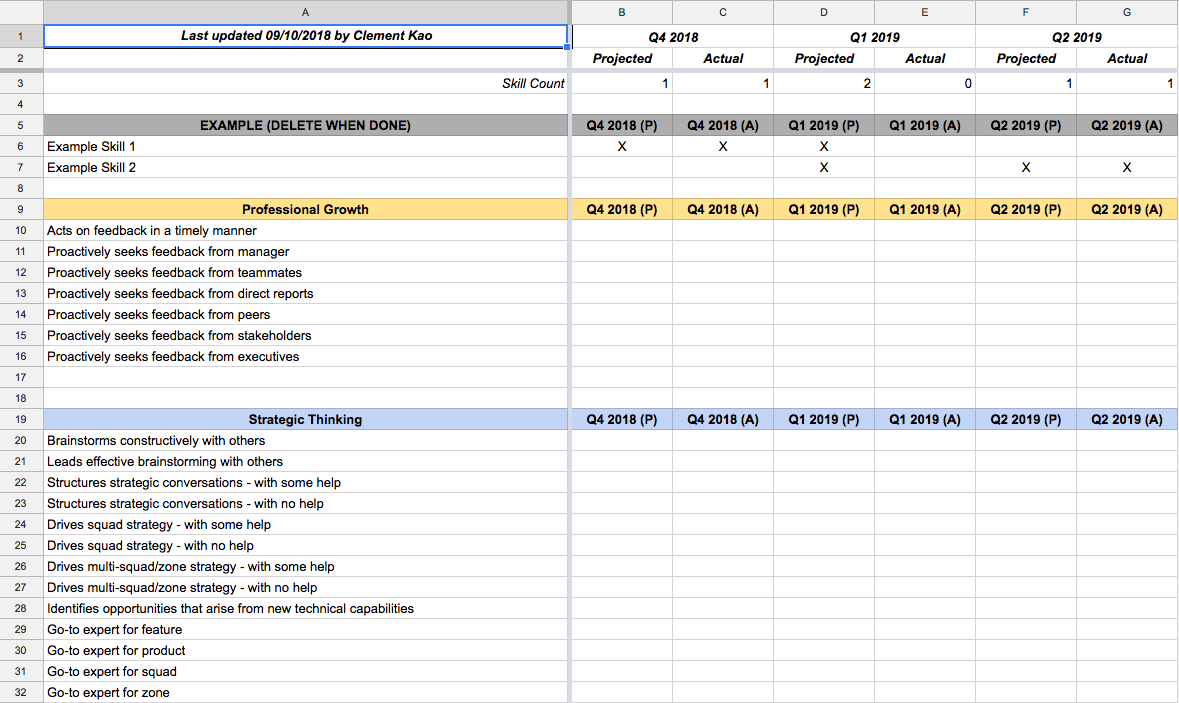As you continue to grow in your product manager role with new responsibilities, you’ll find that you’re entirely in charge of your career trajectory and professional development.
For many, this is daunting. Traditional roles usually have clear guidelines on how to advance upwards, but in product management the path is less clear – since there are so many different kinds of product managers, there’s no single path to success.
So, let’s walk through a framework to help you take control of your career as a PM.
As I’ve mentioned before, product managers are also products, and therefore we can build product roadmaps for ourselves. Any good roadmap contains 3 components:
- Initial state
- End state
- Path to get from initial state to end state
So, let’s tackle each of these three components to build up our professional development roadmap!
Initial State
Let’s start from the start, and define our initial state as a product manager.
Create a skills inventory. As the name suggests, a skills inventory is a simple document that tracks down relevant skills like product marketing, product development, and product strategy. One of my favorite skills inventories is this one by Brent Tworetzky. Below are the skills that he identifies as relevant Strategic Thinking skills:
You can group skills together by theme, or by the kind of stakeholder that you work with.
For example, you could have one set of skills for working with Finance, one set of skills for working with Design, and one set of skills for working with Sales.
List out all of the skills that you currently have. Furthermore, list out the skills that are mentioned in your formal product manager job description.
This exercise is actually much harder than it looks, because you hold many skills that you’re not aware that you hold whether that’s managing cross-functional teams or introducing new products successfully.
For example, here’s how I broke down collaboration skills. Note that I modified the set that Brent identified in his methodology:
- Considered by peers as strong thought partner
- Able to reach objectively good negotiation results while efficiently maintaining relationships
- Participates actively in group meetings
- Leads and facilitates squad meetings with help
- Leads and facilitates squad meetings with no help
- Leads and facilitates all squad PM processes with no help
- Reactively solves problems with other squads/functions
- Proactively identifies potential problems with other squads/functions
- Proactively solves problems with other squads/functions
- Effectively influences the priorities of other squads/functions
- Partners regularly with executive stakeholder
- Demonstrates empathy with cross-functional counterparts
- Has a deep understanding of cross-functional counterparts’ processes
- Reactively solves problems for cross-functional counterparts
- Proactively solves problems for cross-functional counterparts
Of course, you could say “but wait, most of these roll up under problem-solving!”
You’re correct – but we want to be granular enough to define career progression.
If you define a skill too broadly, you won’t be able to define how to grow that skill well.
It’s incredibly difficult to become better at problem-solving as a whole, but it’s much easier to tackle particular kinds of problem-solving.
Now that you know which skills you have, you need to honestly assess your mastery of each skill. It’s important to be honest. If you’re not an experienced product manager or product owner with certain skills, then make sure you note that.
When you define mastery, you can tackle this a couple of different ways. You could use a numeric mastery number (e.g. from 1 to 5), or use categories such as beginner / experienced / expert, or list out a progression of skills with checkboxes.
Brent’s skills inventory takes the skill progression approach, and I’ve modeled my own skill inventory off of such an approach.
Once you’ve defined your existing skills and your level of mastery, run it by a couple of trusted peers and mentors.
Where do they see discrepancies? Are you underestimating yourself or overestimating yourself in particular skills? Is there a consistent pattern?
End State
So now we know what skills you possess. Let’s look at the end state that you’re targeting.
What are the ways in which you want to grow? Maybe you want to be more technically savvy. Or maybe you want to be more design oriented. Or maybe you want to be more data oriented.
Note that your end state should be entirely personalized to you. You shouldn’t wind up with the same set of skills that someone else has – that’s boring! Think about what else you’d want to add. It may be as simple as better communication skills when talking to your development team. Or asking better questions to get the right customer feedback for new product launches.
For example, maybe you want to add in new industry-specific skills. Or maybe you want to be better at business development and partnerships. Or you want to be better at mentoring other PMs, or you want to be a better communicator across the organization.
Once you’ve identified what you’d like your end state to be, add those skills to your skill inventory as well, and clearly indicate that you don’t currently possess those skills.
Of course, you should take feedback from your peers, mentors, and managers as well. Where do they see areas of potential growth? Decide whether you’d like to incorporate these areas of improvement into your inventory as well.
Your Personal Product Management Role
Now we can draw the line from today into the future.
You have your starting state, and you know that you want to get to some future state. All you have to do is plan it out.
All of the concepts that you’ve learned from building roadmaps apply here as well. You have some velocity, some set of priorities, and some kind of backlog.
Think about how you want to progress each quarter or each month. What new tangible skill will you learn from this inventory?
I’ve personally found that by actively planning on learning particularly skills, I was much more likely to have actually obtained that skill.
Furthermore, by planning out the pace of acquiring skills, I was able to grow in a sustainable and realistic way. Moreover, this helped me sync better with team members when product planning and stepping up into the right product manager responsibilities.
Plot out how you want to grow, from a projection perspective.
Then, over time, map out your growth and see whether you’re growing on track.
Here’s a link to a Google Sheet template that you can use. You can copy it by clicking on File in the menu bar, then clicking on “Make a copy…” (if the option is grayed out, make sure that you’re logged into your Google account).
I’ve placed a screenshot below of what the template looks like. Feel free to modify it however you’d like!
Common Pitfalls and Mitigations
While all of the concepts mentioned in this article are common-sense, they’re incredibly difficult to tackle in practice. Let’s discuss common pitfalls as you plot out your professional development, and identify how to mitigate these pitfalls.
The first pitfall is to break down skills in a way where you can work on them tangibly. When I watch others tackle this exercise, I consistently notice that they define skills too broadly.
Push yourself to define skills as granularly as possible – it won’t hurt!
The second pitfall is how you establish your initial state. Much of the time, we underestimate the skills that we are good at, and we overestimate the skills that we are bad at. This is due to the Dunning-Krueger effect.
When you come up with your baseline, be sure to run your self-assessment by others, so that they can provide you an unbiased perspective. If you don’t feel that you have a trusted resource to ask for help, now is a great time to find a product mentor.
The third pitfall is accurately estimating how many skills you can improve in a given span of time. Many times, we overestimate how much we’ll improve in the short term.
To address this pitfall, run a retrospective every month or quarter and see whether your actual velocity matches your planned velocity.
Don’t beat yourself up if you miss your target – it’s nearly inevitable that you’ve overestimated your pace of mastery.
The fourth pitfall is remembering that skills regress over time – use them or lose them.
Honestly, there’s nothing wrong with losing skills if those skills are not relevant anymore. For example, you’re used to leading a product team around a product roadmap, but then join a startup, you will have to adjust from a leadership role to being back in the weeds.
A personal example is when I shifted into a platform product manager role, I experienced a minor regression in my ability to conduct qualitative user interviews, because I no longer relied as heavily on that skill set.
Similarly, when I became a B2B product manager, I experienced a regression in my ability to design system architecture, because I no longer needed that skill set in my new role.
Don’t pretend that you possess skills that you’ve already lost. It doesn’t do you any favors. The more honest you are with yourself, the more control you’ll have over your career.
As a bonus, this skills inventory also serves as a fantastic way to identify other roles that you might want to pivot into. Map out the skills that the new role requires, and look at where you fit well and where you need more work.
Summary
Take charge of your career, and treat yourself as a product. Create a roadmap for yourself by identifying your initial state, your end state, your velocity, and your priorities.
By taking an active approach to your career, you’ll find that you’ll grow much more quickly and be well on your way to becoming a senior product manager. Keep it up!
Want to take control of your own professional development? Chat with other product managers around the world in our PMHQ Community, and boost your skills with our One Week PM course!
Join 30,000+ Product People and Get a Free Copy of The PM Handbook and our Weekly Product Reads Newsletter
Subscribe to get:
- A free copy of the PM Handbook (60-page handbook featuring in-depth interviews with product managers at Google, Facebook, Twitter, and more)
- Weekly Product Reads (curated newsletter of weekly top product reads)
Clement Kao has published 60+ product management best practice articles at Product Manager HQ (PMHQ). Furthermore, he provides product management advice within the PMHQ Slack community, which serves 8,000+ members. Clement also curates the weekly PMHQ newsletter, serving 27,000+ subscribers.



